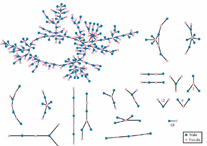

I’m working on a story for a magazine, and am trying to interview young men — in their 20s and 30s — who’ve spent a boatload of cash on their home entertainment systems: Ginormous flat-panel TVs, surroundsound speakers, the whole nine yards.
My deadline is tight — tomorrow afternoon. Know anyone who fits this description? I’d love to hear about it! Send me their contact info, or tell them to email me themselves. If they’d rather not have anyone at work (or their girlfriend or spouse) know just how outrageously expensive the whole outfit was, anonymity is no problem, heh.
Last week I blogged about how extensively I rely on seach engines — sometimes several dozen searches an hour when I’m cranking on research, or perhaps just thinking about a problem. I’ll search, ponder, search again, surf a few links, get up and walk around, come back, do it again. I suggested that “Search engines aren’t merely the way I find information: They’re part of my basic thought processes.”
Then this weekend I read a brilliant, kick-ass piece by Steven Johnson in the New York Times Book Review, talking about precisely this issue. He’s talking about how his thinking processes have been changed by using software like DEVONthink, which finds interesting associations between documents on your computer — your notes, memos, email, unfinished drafts, copies of things you’ve downloaded from the Web, or (in the case of Johnson, a journalist) your articles. I’m going to quote him at length, because he describes the experience so perfectly:
Modern indexing software learns associations between individual words, by tracking the frequency with which words appear near each other. This can create almost lyrical connections between ideas. I’m now working on a project that involves the history of the London sewers. The other day I ran a search that included the word ”sewage” several times. Because the software knows the word ”waste” is often used alongside ”sewage” it directed me to a quote that explained the way bones evolved in vertebrate bodies: by repurposing the calcium waste products created by the metabolism of cells.
That might seem like an errant result, but it sent me off on a long and fruitful tangent into the way complex systems — whether cities or bodies — find productive uses for the waste they create. It’s still early, but I may well get an entire chapter out of that little spark of an idea.
Now, strictly speaking, who is responsible for that initial idea? Was it me or the software? It sounds like a facetious question, but I mean it seriously. Obviously, the computer wasn’t conscious of the idea taking shape, and I supplied the conceptual glue that linked the London sewers to cell metabolism. But I’m not at all confident I would have made the initial connection without the help of the software. The idea was a true collaboration, two very different kinds of intelligence playing off each other, one carbon-based, the other silicon.
You could call it intellectual cyborgism. I love it.

New York magazine just published a column I wrote about the omnipresence of torture in today’s hit spy shows — and how it eerily mirrors the real-life debate over the US’s use of torture. Here are the first two paragraphs:
In the season opener of the spy show Alias, the heroine, Sydney Bristow, was captured and, in the delicate argot of espionage, “interrogated.” The villain shackled her to a chair, strapped a gas mask on her face, and hooked it up to a hose. Then he filled the mask with water—drowning her on dry land as she writhed helplessly.
It was a chilling scene, and not simply because of the violence itself. I realized I was watching a variant of “waterboarding,” the near-drowning torture the CIA has reportedly used on suspected terrorist detainees. I’d read about it in coverage of the Guantánamo hearings that very same morning. And that was hardly the first time a spy show had mimicked a real-life scandal. For the past three years, shows like Alias, 24, and MI-5 have provided a perverse mirror of the real-life response to terror: They’ve reflected, and sometimes eerily predicted, the rise of torture as a government policy.
You can read the rest of the piece online here! Or, bien sur, if you live in New York, you can rush right now to the newsstands and get a copy. Heh.

This is really, really cool: James Moody, a sociologist at Ohio State University, mapped all the romantic and sexual connections that had taken place an 18-month period at a 1,000-person high school, in a rural mostly-white area. Remarkably, he got 832 of the students to talk to him. He mapped out the connections, in that graph above. See that one huge clump? That’s the most interesting part, as a university press release notes:
The most striking feature of the network was a single component that connected 52 percent (288) of the romantically involved students at Jefferson. This means student A had relations with student B, who had relations with student C and so on, connecting all 288 of these students.
While this component is large, it has numerous short branches and is very broad – the two most distant individuals are 37 steps apart. (Or to use a currently popular term, there were 37 degrees of separation between the two most-distant students.)
“From a student’s perspective, a large chain like this would boggle the mind,” Moody said. “They might know that their partner had a previous partner. But they don’t think about the fact that this partner had a previous partner, who had a partner, and so on.
“What this shows, for the first time, is that there are many of these links in a chain, going far beyond what anyone could see and hold in their head.”
There seems to be a quantum leap in the size of one’s zooming network. Either you belonged to that enormous, borg-like structure — about half the students — or you belonged to a very small, sealed-off network of three or fewer students. There was almost no-one in the middle: Almost no-one in a network of 4 to 15 students. In a way, it freakily reinforces the age-old virgin-whore typology of teen sexuality. Kids who wanted to be exclusive and monogamous dated likeminded kids, producing the sealed-off small networks; kids who dated more freely would hook up with those who also dated that way, producing the massive, interlocking chain.
This might be useful data in understanding how sexually-transmitted diseases spread in high schools. I’d be even more fascinated to see what the patterns would look like in one of those schools where students take the “chastity pledge” not to have sex before marriage. A while ago, I read the study that two professors did of the pledge’s effect (a PDF of it is here) and it was quite interesting: Taking the pledge greatly delayed whether a teenager actually had sex, to the extent that a non-pledging teenager was as likely to have sex with his/her first dating partner as a pledge-taking teenager who was on his/her fourth dating partner. The problem, the scientists discovered, is that the pledge only worked if the pledge-takers comprised a minority of the highschool population. That’s because the pledge was regarded as a badge of nonconformist pride. Ironically, if too many people in the school actually take the pledge, it doesn’t work any more. Worse, when pledge-takers eventually did have sex, they were far less likely than non-pledge-takers to use birth control and to guard against STDs. (Notably, when the government officials released these results and proudly announced that pledges were an “effective tool”, they downplayed this latter finding and completely failed to report the fact that the pledge works less the more people take it.) Anyway, I’d love to see what one of Moody’s charts looks like for a “pledging” school!
The other question, of course, is whether the kids were actually telling Moody the truth. There would be all sorts of reasons for teens to lie — either overreporting (to seem sexually adventurous), or underreporting (to keep from looking like they were too loose).
(Thanks to Boing Boing for this one!)
Want to lose weight? Try fidgeting. Scientists at the Mayo Clinic have just published a study in which they outfitted 10 skinny men and women — and 10 overweight ones — with sensor-equipped underwear that measured, with minute precision, how much they moved around during the day. The results? The overweight people tended to sit still all day, while the skinny ones would pace and fidget, spending two hours more on their feet each day. As the New York Times reports:
The difference translates into about 350 calories a day, enough to produce a weight loss of 30 to 40 pounds in one year without trips to the gym - if only heavy people could act more restless, like thin ones.
Even more interestingly, one’s activity level predicts one’s weight, and not vice versa — or, more simply, the skinny people seemed to be innately predisposed to fidget. When they were forced by the scientists to gain weight, the skinny people still kept up their fidgety ways. (Amazingly, to ensure they knew precisely who many calories the participants were eating, the scientists had a 150-strong staff actually cook meals for the participants for weeks at a time.) This finding is kind of sucky, though, because as one scientist noted ….
… because the tendency to sit still seemed to be biological, it might not be easy for obese people to change their ways. “The bad news,” Dr. Ravussin said, “is that you cannot tell people, ‘Why don’t you sit less and be a little more fidgety,’ because they may do it for a couple of hours but won’t sustain it for days and weeks and months and years.”
Either way, it’s interesting news for me. I’m a pretty slender guy, but I never formally exercise; after gym class stopped being mandatory in grade 11, I have pretty much avoided every playing any sports whatsoever, and that was 18 years ago. But I fidget like a psychopath — so wildly and spastically that I when I work in an office, I actually kind of freak out my officemates — and my normal walking speed is easily twice that of people around me; plus, since I live in New York and never drive anywhere, I walk really long distances every day. I used to figure that my weight was inherited from my paternal grandfather, who also was skinny. But now I’m interested to know: Precisely how energy do I burn off with my ADD-like fidgeting?

Several times in the past, I’ve blogged my thoughts on why video-games make terrible vehicles for storytelling — and why those who seek to “tell stories” via games fundamentally misunderstand the basic nature of narrative. For my latest Slate column, I did a version of my longstanding rant on this subject. A snippet:
For many designers, crafting bravura cutscenes has become the best way to transform a mere game into a genre-smashing event. When Halo 2 shipped, for example, the game’s creators bragged that they had created nearly a feature film’s worth of scripted scenes. These Hollywood flourishes are good for dazzling mainstream journalists and pundits. That’s because there’s still a weird anxiety about adults playing games. Most people still think that video games are sophomoric kid stuff; the ones that have a narrative and emulate the movies seem more serious and, well, mature.
The column has prompted a storm of criticism over at Slate’s discussion board, The Fray. It’s worth checking out — there are several extremely smart, perceptive posts: This is one of my favorites!
I’ll blog more, later, about some of the other responses I’ve gotten, including several game designers who wrote to agree with me, and/or take issue with how broadly I dismissed the idea of narrative.
Here’s an interesting bit of research that ripped my head off. The Pew Internet & American Life Project just did a survey on how people search the Net. Among their findings:
Nearly half of searchers use a search engines no more than a few times a week, and two-thirds say they could walk away from search engines without upsetting their lives very much.
They could “walk away from search engines without upsetting their lives very much”?? This fascinates me, because my own experience is so radically, fundamentally, insanely different. During the workday, I use search engines several times an hour — and for several extended periods during the day I’ll be doing queries several times a minute. If I were to average it out, I’d say I probably do a search every 15 minutes while I’m at work at my desk. Obviously, I skew pretty far off to the side of the bell-shaped curve here because I’m a) a journalist, b) a technology journalist, c) a blogger, and d) someone who regards the Internet, functionally, as a part of my consciousness. Search engines aren’t merely the way I find information: They’re part of my basic thought processes.
Wow.
(Thanks to Boing Boing for this one!)

Apparently Glad has scored a bit hit with its new ForceFlex garbage bags — which can stretch to seemingly impossible dimensions, and thus contain the ever-greater volumes of nonrecyclable carcinogens the average American family craps out every day. (“Hey honey, Johnny doesn’t like his Jungle Gym anymore!” “No problem, sweetie — we’ll just shove it inside a single ForceFlex garbage bag and send it off to the dump so Johny’s grandchildren can drink the entire goddamn thing 80 years from now when it leaches into the water table.”)
Anyway, there’s a great piece by Brendan Koerner in today’s New York Times, in which he interviews Glad and discovers some interesting facts about the design process:
A ForceFlex bag looks a bit like an overgrown paper towel, with row upon row of embossed diamond shapes. Those patterns, explained Shaun T. Broering, Glad’s technology leader, make the bags stronger and more flexible: each diamond is ribbed with tiny indentations, which can puff out considerably when pressure is applied from within.
Glad, a subsidiary of the Clorox Company of Oakland, Calif., spent several years adjusting ForceFlex’s diamonds for design and maximum strength. They could have chosen bigger diamonds, which would have allowed the bags to better withstand errant chopsticks or cereal-box corners. But consumers who tested early ForceFlex prototypes were wary of too much of a departure from unadorned bags.
“When the diamonds get too big, that’s a real problem for us,” said Eric Reynolds, a marketing manager at Glad. “We can’t push consumers too far.”
No wonder this country has such trouble dealing with the impact of consumption on the environment. Not only do we have no problem with generating enormous amounts of trash — but we’ve got an aesthetic for it.

We now officially live in the age of the forensic cop show — where police rely not on brass knuckles to bring down perps, but on science. Ever since CSI swept prime time, networks have stumbled over each other to produce ever more procedural dramas where police scientists squint into microscopes and deliver mind-numbing lectures on the how the curl of human hair relates to the ovoid shape of its cross-section. Real-life cops and scientists have a love-hate relationship with these shows, because of two problems: a) The shows create an unrealistic sense of how accurate and easy-to-use these techniques are, and b) juries now expect to be treated to explanations as pat and simple as those in the shows, accompanied, bien sur, by lavish CGI animations.
Anyway, I was intrigued to hear about the premise of CBS’s new procedural thriller (and 1337-speak titled) Numb3rs. According to the New York Times:
Charlie looks at a water sprinkler and has an Archimedes moment: he realizes that the same mathematical principle that allows him to track the path of drops to determine their point of origin could be applied to the distribution of crime scenes on a map. “Are you saying you can tell where the killer is?” Don says slowly and ponderously. His partner drills in the point, saying wonderingly, “If it works we have a whole new system of investigating criminal cases.”
When I read this, a bell in my head went off — because I realized this is “geographic profiling”, a technique invented in 1990 by Vancouver police officer Kim Rossmo (pictured above). In the 80s, criminologists Paul and Patricia Brantingham had proved that serial criminals tend to stick close to home when they commit their crimes. Rossmo took this concept a step further, as a writeup on a criminologist web-site notes …
Rossmo reasoned that if the serial criminal operates close to where he lives, it may be possible to approximate the location of his home by analyzing spatial patterns of the attacks. To test the theory, he wrote a program using proprietary algorithms and statistical analyses of serial crime data collected over several years. The program also incorporated a hunting typology of serial criminals based on the research. When later reviewing George B. Schaller’s authoritative work, The Serengeti Lion, Rossmo found startling similarities in the hunting patterns of African lions and city-dwelling predators.
“Schaller’s typology of how lions hunt matched almost perfectly with the hunting typology of the serial killer. Lions look for an animal that exhibits some indication of weakness — the old, the very young, the infirm, the vulnerable. They will go to a watering hole and hang out because they know it is a draw for their potential targets. We see that all the time with criminal offenders; they go to target-rich environments to do their hunting. Spatial patterns are produced by serial killers as they search and attack. The system analyzes the geography of these, the victim encounter, the attack, the murder and body dumpsites.”
Cool, eh? Which is why I was surprised to find that of the nearly two hundred stories written about the show in the last week, only one actually mentions Rossmo and his work — and that was the New York Post quoting an observation in an online chat room.

Techies and copyright activists care a lot about digital-rights management. But the average person? He couldn’t care less. This isn’t because he’s dumb, or because DRM and copyright aren’t incredibly important issues. It’s because they’re often too abstract to seem real.
Right now, the only time people are likely to even notice DRM is with their music and software. And even then, they usually don’t see what’s going on. People tend to behave as if the songs they buy from iTunes or the software they buy from Microsoft are property that they own; they rarely read the fine print to discover that actually all they’ve done is acquire a license to use the “content”. If the company that issued that license decides to change its mind later on, it can reach into your computer, Tivo, or iPod, and remove that stuff you thought you owned. Nasty, eh? Except this doesn’t happen frequently enough or noticeably enough — not yet, anyway — for most people to have had an experience with it. So the big challenge for DRM and copyright activists is simple: Figure out better ways to help the average person understand what’s at stake.
That’s why I was so tickled to hear about “SeatSale”, the art project by cyborg expert Steve Mann. It does a brilliant job of making DRM both concrete and hilariously scary.
SeatSale is a chair that has spikes on it; to sit down, you have to get a “license to sit” that will temporarily retract the spikes. To get a license, you have to swipe your credit card — or “government issued photo ID card” — and agree to the “terms and conditions”, which are themselves a hoot:
1. You agree not to attempt to understand how chairs work.
2. You agree not to try to discover how software works.
3. You agree not to practice the Scientific Method (TM).
The license is “free” — in the sense that the chair doesn’t charge you any cash to sit in it. And indeed, that’s partly what many DRM people argue too — that the DRM restrictions they put on their content, be it software or music, don’t “cost” the user anything; you get to use the software or listen to music so long as you’re using an approved device, right? But what SeatSale shows is that DRM has many hidden costs. When you swipe your card you’re telling the government where you’ve been, where you’ve sat, and how long you were there, for example.
We need more stuff like this.
(Thanks to Boing Boing for this one!)
Two years ago, PC Mag tech columnist John Dvorak wrote a piece entitled “Free porn”, to prove that merely including those words in an article would massively increase the traffic for that piece — since pornhounds regularly search for that phrase and will click on anything that seems to point to that promised land. Apparently, it worked. Two years later, that column has remained on the most-read list of articles at PC Mag’s site. As Dvorak notes:
Just the use of the word is enough to pump up the numbers. Are online readers so drawn to porn that they aggressively seek it out? No wonder the amount of pornographic e-mail come-ons has been slipping. Why bother with spam? Just set up a porn site and the readers will seek you out.
I can only assume that in the USA in particular there is some sort of pent-up demand for porn. I think this is because we make such a fuss over it, as if it’s so horribly dangerous. Even the suggestion of nudity, as in that ad for Monday Night Football with Terrell Owens and Nicollet Sheridan, turns out to be scandalous, as seen by the reactions to it from the NFL and the Federal Communications Commission. And there are all these objections to how online people flock to porn! Does anyone find this odd and disturbing?
I’ve noticed this phenomenon myself. Not long after I launched this blog in the fall of 2002, I crunched my site-visitor statistics and noticed that a huge amount of people were arriving at my site because they’d searched for “upskirting” on Google or Yahoo — and found me. Why? Because I’d blogged about people using mobile phones for upskirting and, given the amount of Google juice I’ve got, I was displaying as a high result. I just checked this again on Google and, sure enough, I’m still the number two and three result for “upskirting”.
Now that I’ve combined the magic words “free porn” with “upskirting”, I figure that in about a week or so this posting will be the most-visited page in the universe. Heh.
(Thanks to Boing Boing for this one!)

Tony Blow, a longtime commentor on Collision Detection and publisher of Typescape, has just launched the Squidblog — a blog for people “who are fascinated by giant squid and related semi-mythical creatures.” There could be no task more noble. This thing is now a daily part of my news diet.
And this month was a hell of a propitious time to start a blog about squid, because of the recent invertebrate invasion! Last week, about 1,500 jumbo squid washed up dead on the shores of Orange County in California. As The Seattle Times reported:
“These things are invading, and we don’t know what’s going on,” he said. “It may be they’re following a warm California current. Oceanographers don’t have a clue why a large population of squid like this is moving north or why they strand themselves.”
One theory is that fisheries have sufficiently depleted the area of sharks and and big tunas that the squid can now “forage without a threat”.
(Thanks to Tony for this one!)

A couple of sleep-deprived geeks figured out a neat hack: They used a simple Linux command to get their computers to “listen” to various bits of data the computer was generating — from random numbers to the hard-drive activity — and outputted it as audio files. It’s pretty wild-sounding stuff, much like the parrot-like squawk of an old-skool modem. Then they ran a few highly-structured bitmap images through, such as the American flag above. The results are oddly musically tenable: The digital anthem.
(Thanks to Jason Uechi for this one!)

My friend Andrew Hearst just launched panopticist, his new blog! It’s really excellent — he’s posting mostly about media and music, since he’s both an editor and a musician. Yesterday he wrote a funny post pointing out how incredibly gross the listening stations at music stores are — since you have to put on headphones worn by previously thousands of sweaty fellow citizens who aren’t in the habit of showering or “delicing” themselves. He came up with an elegant solution:
So here’s an idea: Record stores should retrofit their listening stations with 1/8” headphone jacks so owners of iPods and other portable music players can plug in their own headphones. A significant percentage of iPod owners probably carry their iPods with them wherever they go, and so do many owners of CD Walkmans and other portable players. I’m guessing that many of those people would be more likely to check out a few artists on a listening station if they could simply pull out their own earbuds and plug them in.

Heh. Some Japanese company has released the above-pictured Big Red Button device, and as Ryan at Engadget notes, it might be merely a cold-war desk ornament. But, as he goes on to joke …
… if they set it up as a single configurable key via USB, well, we’d be in bliss. Though you shouldn’t need to ask, you may want to know what application it would open? Internet Exploder, what else?
If this thing actually is a USB controller, I AM SO GETTING ONE.
(Thanks to Gizmodo for this one!)

This is just brilliant. Some geek wired up his Playstation 2 controller to his computer, and had it do a brute-force attack on Grand Theft Auto: San Andreas, trying out thousands of button combinations — in an attempt to find secret game-cheats. It worked: He discovered several hilarious ones, including:
Cars Fly
UP, DOWN, L1, R1, L1, RIGHT, LEFT, L1, LEFT
But not like the old Dodo cheat. You have thrust while you’re in the air, and can go faster than any airplane. Great for bookin’ around the map from place to place.Mega Punch
UP, LEFT, X, TRIANGLE, R1, CIRCLE, CIRCLE, CIRCLE, L2
Punches send people flying into the next block. One hit kills. Watch out, peds have it too!
I particularly love that former cheat, since it reminds me of the Matrix-like quality of gamespace. Much as in a dream, when you’re inside a game, you can oftentimes do something — type in some subtle cheat code — that transforms the nature of the world, and suddenly, hey, you’re flying! (Actually, in his book Playing the Future, Douglas Rushkoff argued that games could quite precisely be compared to dreams, and that this is why they ought to be analyzed with psychoanalytic rigor.)
More importantly, this guy’s discovery reminds me of the weird semantics of game “cheats”. Because of course, most of today’s cheats really aren’t cheats, at least not in the classic sense of cheating. The early cheats — such as the famous Asteroids cheat that gave you hundreds of extra men — were genuine bugs, little burps in the code that were included by accident and discovered by sneaky, infinite-monkey gamers. By the mid-90s, game designers realized the cheats were so popular that they began actively designing secret codes into the game. At this point, discovering a cheat was no longer an illicit affair; you were merely happening upon an extra easter egg the programmers had included specifically for you to find. But since gamers love feeling like rebels, the game companies continued to call these things “cheats”, even though the companies began profiting wildly by publishing guides to the cheats.
Antonio Gramsci couldn’t have dreamt up a better illustration of hegemony.
Nonetheless, this guy’s discovery of the new San Andreas cheats falls somewhere close to the original meaning of “cheat”. His discoveries were genuine secrets: Though Rockstar’s designers obviously programmed them intentionally into the game, they have never actively published or promoted them.
(Thanks to Slashdot for this one!)

In today’s New York Times, there’s an Education article talking about the demise of proper cursive handwriting among high-schoolers. Computers have drastically reduced the amount a student writes by hand, so much that the skill, “like an unused muscle”, is pretty much dead by your senior year. But there’s an interesting question buried in this piece: What is the cognitive effect of handwriting versus typing?
According to one researcher, kids who were bad at handwriting did worse in tests — not because they were stupid, but because the mere act of enforced handwriting chewed up too much processing power, leaving them little left over to focus on the intellectual task:
Professor Graham’s study of elementary school pupils indicated a link between their difficulty in handwriting and weaknesses in the grammar and content of their compositions. One reason, quite simply, is that a brain struggling to make a hand form letters does not devote enough attention to more advanced tasks.
This, the reporter suggests, is a good reason why it’s best to leave keyboard-trained kids at the keyboard. After all, the keyboard dominates most of the professional jobs they’ll hope to get. And they perform better while typing, since it’s their natural output device:
In high school and college, any student without a 24/7 laptop cannot hope to keep accurate notes on a lecture course. Kate Gladstone, a handwriting specialist based in Albany, estimates that while a student needs to jot down 100 legible words a minute to follow a typical lecture, someone using print can manage only 30. “That’s fine for class,” she said, “if the class is first grade.”
For me, there’s an even deeper question: Are there any qualitative differences — in the way you think, create, or express yourself — between handwriting and typing?
When I’m reporting a story and taking notes, I often talk on the phone and type notes; since I type about 70 words a minute, I can catch nearly every word. When I’m out in the field and reporting, I use a notepad, so I’m forced to be much more selective in what I write down. In essence, I begin the editing process — redacting the data, picking useful bits — while taking handwritten notes. When I’m typing, I don’t need to make those choices; I simply record everything, and figure out later on what’s useful and what’s not.
Here’s another example: I never write entire pieces of journalism by hand, but I do sometimes make outlines on notepaper. And I’ve noticed distinct differences between the two modes. When I’m thinking about the logical connections between different parts of my argument, for example, I’ll draw big swooping arrows connecting points together — something that can’t be done easily in a word processor. In a word processor, however, I’m able to use the classic DJ-style writing technique — cranking out chunks of text and remixing them via cut-and-paste.
I once got in an argument with Frank Wilson, author of the excellent book The Hand: How its use shapes the brain, language, and human culture, about the cognitive impact of typing versus writing. He didn’t think there was any difference between the two. He also didn’t buy my argument that typing has aesethetic pleasures of its own, which is why so many geeks prefer keyboards with a distinct “click” on the keys.

New York magazine just published an issue devoted to “stress and the city” — and for it, they asked me to write a piece on the latest scientific research into why cities can be such fist-clenching places to live. Here’s my personal favorite bit of research I stumbled upon:
In fact, just crossing New York City borders is enough to set your teeth on edge. In 1999, Nicholas Christenfeld, a psychology professor at the University of California, examined the national rates at which people die of heart attacks. In New York, he noticed, the rates are 55 percent higher than the national average. “It stands out like a red light on the map,” he says. Then Christenfeld examined the rates of heart attacks among visitors to New York. Amazingly, those numbers were also elevated—34 percent higher than normal. The reverse was also true—when New Yorkers travel to other parts of the country, their rates drop below the city’s norm by 20 percent.
Turns out your paranoid mother was right: The city really will kill you. “It’s incredible,” Christenfeld marvels. “Just by visiting New York, you pick up half of the stress effect of living there. And you can shed half of it by leaving.”
You can read the rest of the story online here — or, if you live in New York, pick up a print copy yourself and see the whole package!

The Sunshine Project is an activist group that studies the US government’s research into chemical and biological weapons. They file lots of Freedom of Information requests, and one of their latest ones discovered something quite hilarious. Apparently, in 1994, the military considered a proposal to research a “gay bomb” that would make enemy soldiers “sexually irresistible” to each other. As the BBC notes:
The plan for a so-called “love bomb” envisaged an aphrodisiac chemical that would provoke widespread homosexual behaviour among troops, causing what the military called a “distasteful but completely non-lethal” blow to morale.
The military claims this proposal was immediately rejected, but the Sunshine Project says that it was still being pondered as late as 2001. I can’t figure out who to believe. On the one hand, the idea is so laughable it would seem impossible anyone would take it seriously; then again, the military is so massively deranged about homosexuality that I can almost believe it.
(Thanks to Noah for this one!)

Ten minutes ago, I wrote the following blog post …
Here’s some less-depressing news about the tsunami: It flew inland with such force that it deposited a whole pile of weird-lookin’ sea beasts on the ground. A discussion board for deep-sea divers has posted a bunch of pictures of them here!
(Thanks to Noah for this one!)
… and instantly a couple of astute readers posted notes on the comment areas noting that the pictures on that discussion board aren’t from the tsunami; they date back to a mid-2003 ocean exploration voyage, as noted on the Snopes urban-legend-busting site.
I love the speed at which incorrect stuff gets fact-checked online! Thanks all around.

Samsung has announced a new phone that will have an “accelerometer” in it, allowing you an unique way to do data input — you wave the phone around in the shape of the thing you’re trying to spell. Draw an “O” in the air, and you type “yes”; an “X” types no. The idea is so spectacularly daft that you have to wonder: Has the designer ever met anyone who actually uses a phone? Like, in public? I was impressed that CNET was actually able to find an analyst willing to take this idea even half-seriously:
“This is characteristic of the types of enhancements you’re going to see made to cell phones going forward,” John Jackson, senior analyst, Yankee Group, told TechNewsWorld. “It’s designed to beget innovation and beget development; it’s an enabling technology.”
Enabling, yes … in the sense that it will enable mobile-phone users to inadvertantly bash in the heads of innocent bystanders while frantically attempting to “type” CUl8r on their phones. Saved by technology.
I’m being mean. The truth is, haptic sensing is actually a sort of interesting concept for interface design. As phones get smaller and smaller, and there’s less and less room for buttons on their screens, a motion-sensitive phone could offer some intriguing ways to manipulate data. If you’ve got a big list of phone numbers, you could tip the phone forwards and backwards as a way of scrolling through a long list, and shake it once quickly to select one. Indeed, several interface designers have played around with these concepts. What’s neat about haptic interfaces is that they turn data into something physical — as if the lists of phone numbers on your phone were a long list of beads you could roll back and forth.
You could make some pretty kick-ass games for that phone, too. How about a sword-fighting game, where you physically swing the phone around to perform moves? Or to cast spells in an RPG, with the precision of your swing determining the success of the spell? Come to think of it, the only successful haptic data-manipulation device that I’ve ever seen was, in fact, a game: Kirby Tilt ‘n’ Tumble for the Gameboy, where you moved Kirby around the screen by tilting the screen around.
(Thanks to Gizmodo for this one!)

No comment necessary. As the Associated Press reports:
A painting by a talented pachyderm at the Fort Worth Zoo has raised $7,000 for tsunami victims.
An original work of art by “Rasha” the Asian elephant was auctioned on e-Bay.
Zoo officials said Wednesday the winning bid came from North Hills Lincoln Mercury in Hurst.

There’s no future like the old future. Pick up any piece of sci-fi today, and odds are you’ll find some incredibly dystopic vision of the world to come: Slave-labor telepresence work, neurally-implanted advertising, blissed-out teens on dumbdrugs. Bleah. What happened to the old, superoxygenated, go-go dreams of a rocket-finned future?
Back in 1961 … now that was when the future meant something. That’s when some florid hack penned a piece in which he asked “Will Life Be Worth Living in 2000 A.D.?”, a question he immediately answered with a resounding HELL YES. Though the article is a total laff riot, it amazingly manages to get a few predictions half-right — it says that “there will be machines doing the work of clerks, shorthand writers and translators. Machines will ‘talk’ to each other”, and it argues that “mail and newspapers will be reproduced instantly anywhere in the world by facsimile”. But my favorite part is when the author gets to the irreplacable linchpin of any self-respecting postwar vision of the year 2000: Personal jetpacks. From a web-site reproduction of the article:
It will be the age of press-button transportation. Rocket belts will increase a man’s stride to 30 feet, and bus-type helicopters will travel along crowded air skyways. There will be moving plastic-covered pavements, individual hoppicopters, and 200 m.p.h. monorail trains operating in all large cities.
The family car will be soundless, vibrationless and self-propelled thermostatically. The engine will be smaller than a typewriter. Cars will travel overland on an 18 inch air cushion.
“Thermostatically”?
I also liked the final paragraph: “It’s the way they think the world will live in the next century - if there’s any world left!”
Ah yes: If there’s any world left. Gotta love the emotional whiplash course-correction, in which the cheery, pipe-smoking affability of the author descends, with no warning whatsoever, into completely sociopathic Cold War duck-and-cover nihilism.
(By the way, looking at the piece again, I’m half wondering if this is not in fact an actual repro of a real article, but a modern parody of one. Anyone out there know?)
(Thanks to Sean for this one!)

About ten years ago I started to cultivate a less-affordable-than-I’d-like fetish for suits and ties. It’s awfully weird for a guy who works in a home office, but there you go; you can never have too many pointless affectations, I always say.
Anyway, this is why I was tickled to discover the Emergency Cufflinks created by Touch of Ginger. They’re constructed of a credit-card sized, thin piece of stainless steel. Just punch ‘em out, fold the ends, and voila: Instant pseud cred!
(Thanks to Sensory Impact for this one!)
My friend David Wallis runs Featurewell, an amazing service that syndicates high-quality magazine journalism. He also edited Killed, a terrific anthology of “Great Journalism Too Hot To Print” — stories so politically explosive their editors opted not to run them.
David’s in touch with tons of excellent writers, so he’s organizing “Thrown Together”, a literary reading to raise money for tsunami relief. If you’re in New York on Jan. 23, here are the details:
THROWN TOGETHER
A reading to benefit Tsunami survivors
Jefferson
121 W. 10th Street
New York City
Phone: (212) 255-3333
Sunday January 23, 6-9 PM
Complimentary Hors d’ouevres/Cash Bar/$15 at the door
The reading will include Adam Goodheart (a founding editor of Civilization), Ayun Halliday (author of No Touch Monkey: And Other Travel Lessons Learned Too Late), Suketu Mehta (Maximum City: Bombay Lost and Found), Bob Morris (who writes the Age of Dissonance column for the New York Times Sunday Styles), Daniel Asa Rose (Hiding Places: A Father and His Sons Retrace Their Family’s Escape from the Holocaust).
All funds will go to Oxfam’s Asia Earthquake Fund and Heifer International’s Tsunami Rebuilding Efforts. Heifer rocks; it was my favorite charity to donate to in 2004.
My mother lives in a sort of technological time capsule. She has no email address; in fact, she’s never used the Internet. She does not even have voice mail or an old-school answering machine. That latter fact means that every once in a while when I call her, I hear an incredibly rare sound — a busy signal. Given the preponderance of voice mail today, one almost never hears that anymore. A busy signal belongs to an interesting and growing category: Sounds that are becoming technologically obsolete.
That’s why I really dug this story in the Fort Wayne Journal, profiling the guy who heads up the Smithstonian’s effort to collect and preserve recordings of all these extinct sounds. Check it out:
Inside a bombproof vault a few blocks from the White House, Dan Sheehy is surrounded by audio ghosts: the clickety-clack of typewriters, the tumble of glass bottles inside a soda machine, a 1960s-era telephone ring.
Here, sonic blasts from the past are entombed in a hodgepodge of vinyl records, compact discs and reel-to-reel tapes. “We are a museum of sound,” said Sheehy, whose job is to preserve America’s acoustic heritage for an obscure branch of the Smithsonian Institution.
Sounds are like smells, he says. They can transport the listener to another time and place. The buzz of an airplane propeller sends Sheehy’s mind back to hot afternoons in 1950s Bakersfield, Calif., playing in the yard while aircraft sputtered overhead. “The sound immediately triggers memories of time and temperature,” he said.
(Thanks to Boing Boing for this one!)

I used to love making paper snowflakes when I was a kid, but there was always a problem of structural fidelity. If you cut an overly intricate pattern, the flake would be more air than paper; it was thus really hard to open the flake up, and and once open, it would flop all over the place, like a doily from hell. Being a math-nerd kid, I was continually trying to create Xtreme snowflakes with deranged fractal patterns, but it was totally frustrating.
Imagine my joy, then, to discover Make-A-Flake, an online app that allows you to create a virtual pattern! Much, much easier to go to town with whatever byzantine pattern you can dream of. That one above I did on my first try.
As we slowly but methodically replace all the homespun joys of childhood with their virtual replicants, there’ll be no reason for the kiddies to ever leave the keyboard.
(Thanks to Incoming Signals for this one!)

Here’s a cool app: Sidestepper, a generator of “relational architecture”. Input any URL, and Sidestepper scours the site for images and text, and inserts snippets of them into a 3D living room. That room above is Sidestepper’s rendition of Collision Detection. Squint, and you can see that the picture on the left is the intro text from my site — “I’m Clive Thompson, a writer on politics, technology, and culture …” — and the picture next to it is of the baby hippo I posted about on the weekend. The room is fully 3D, so as I explored it I found other images and bits of text scattered around. My favorite detail: The image of the TR-3B government UFO is showing on the television.
(Thanks to the J-Walk blog for this one!)

Ever since the lafftastic 1982 Tom Hanks vehicle Mazes and Monsters, social critics have lambasted fantasy games and video games for making kids “unable to tell the difference between a game and reality.” I’ve always thought that is transparently untrue. Indeed, that attitude seems less like an indictment of the brains of gamers than the brains of the critics: The latter are clearly so unaccustomed to using their imaginations in vivid ways that they immediately regard anything fantastical as being too much for the brain to handle. (It’s the same way with the weirdly naive, overenthusiastic reception of The Matrix by clueless mainstream pop critics, who were clearly similarly unaccustomed to talking about even rudimentarily philosophical ideas. “Wow! What if the whole world were an illusion? What a … wild new idea!” <mount high horse> Yeah, well, pal, if you’d looked up once in a while from your diet of toffee-nosed kitchen-meandering literary fiction, Friends and celebrity gossip, you’d notice there’s this thing called science fiction that’s been around for about two hundred years, in which the basic premise of The Matrix is so well-known and well-discussed that it is nearly hackneyed. Oh, and, yeah, while you’re at it, here, you can borrow my copy of The Republic, asshole.)
Anyway. </mount high horse> The point is, I’ve always disagreed that video games render you unable to distinguish reality from a game; the only people who believe that are ones who don’t play games themselves.
However, it is true that games sometimes do some pretty weird things to your sense of perception. Anyone who’s stayed up until 4 am playing a game knows that when you try to lie down at night, you can still see the game: You’re still there, running through the corridors of Halo 2, peering down on the isometric Sims, or watching the Tetris bricks fall through the infinite Euclidean freespace of your brain. And this sometimes happens in waking states, as a story in today’s Wired News points out. The reporter interviewed several gamers to get their weirdest or most embarassing moments of elision between the game world and the real world, including …
After a recent three-day binge of playing the Japanese cult hit video game Katamari Damacy [pictured above], Los Angeles artist Kozy Kitchens discovered that walking away from the game was not as easy as putting down her joystick.
In the game, players push around what amounts to a giant tape ball, attempting to make the ball bigger by picking up any and all objects in its path. Kitchens found that her urge to keep picking things up was not so easy to shake.
I was driving down Venice Boulevard,” recalled her husband, Dan Kitchens, “and Kozy reached over and grabbed the steering wheel and for a moment was trying to yank it to the right…. (Then) she let go, but kept staring out her window, and then looked back at me kind of stunned and said, ‘Sorry. I thought we could pick up that mailbox we just passed.’”
My experience of game/world blending doesn’t work quite like that. I’m more prone to simply think of far-off objects as being more proximal to me — as if I could reach out and touch them, and have them transform into something else, or release their essence, in the sort of Mario-born idea that powerups are locked within everything around you.
I actually think this mental state can be kind of lovely.
Daniel R. Luke, one of this blog’s readers and frequent posters, recently emailed me to point out an interesting asymmetry in the blogosphere: People who post lots of comments to blogs have no way of easily assembling, re-reading, or presenting their epistolary output. Then he unleashed an incredibly sharp idea:
Comments should be searchable. I should be able to aggregate all comments I or someone else has left on a particular blog. Ideally, this should
span the entire blogosphere so that I could aggregate all the comments I have left on all blogs. It would be easy, then. to see where people go and what they say. This way the audience of the blogosphere would be much more empowered. In essence, I wouldn’t necessarily have to start my own blog to, in effect, have a blog of sorts.
This is a brilliant concept, and one that could add a wild new dimension to the blogosphere. Maybe there could be an online service — much like, say, Typepad — that allows you to quickly set up a comment-blog that will automatically aggregate your comments and present ‘em, like a blog of its own? Another way to do it would be to tinker with RSS so that one could allow RSS agregators to “tune in” to the postings of a particular poster. (Is that latter concept already possible? I don’t know enough about RSS to tell.)
However, I can say this: Comments are often some of the most interesting things about a good blog, and people who are prodigious commenters are following in a grand literary tradition. I’d be fascinated to see all their comments in one place, as a literary artifact. It’d also open up interesting new ways to explore blogs, since a commenter is an interestingly organic thread connecting various and sundry blogs together. Imagine surfing blogs by reading an item, finding a particularly smart comment, then being able to see all the items that person has commented on at other blogs.
When I first read Daniel’s idea, I immediately thought of a name for it: the commentosphere.
As it turns out, a few other people have used the same term, though their thinking has gone only so far as the desire to create permanent links to individual comments, so that a blogger can point to a cool comment at another blog. But Daniel’s idea goes one smart quantum-step further. I would absolutely love to see some smart coder tackle this one.
(Thanks to Daniel for this one!)

Readers may recall my sad, failed attempt to get the now-defunct customize-your-own-stamp company PhotoStamps to print stamps featuring “Surly Squid”, a piece of art by my artist friend El Rey. They claimed that the image — a little, scowling orange squid — was somehow objectionable, but they never explained precisely how or why.
Nonetheless, it appears that while The Man down here in the US is hotly opposed to cephalopod philately, the Canadian postal service has no such compunctions. Back in 1990, they even created their own stamp specifically to commemorate the Kraken! That’s it pictured above — and it’s taken from Philip Burns’ excellent web site, at which he has collected an amazingly comprehensive archive of pretty much every giant-squid-themed stamp that has ever been printed.
(Thanks to Brian for this one!)

Last year, the Game Developer’s Conference hosted an interesting event: A “Game Design Challenge” in which three well-known designers were given an unusual criteria around which they have to design a (theoretical) video game. Last year, the challenge was to develop a game in which the core mechanic was “creating a love story”. The winner?
“Collateral Romance”, a concept by Will Wright, the genius creator of The Sims (who I profiled a year ago for Psychology Today). The concept of the game is that it takes place within another war game, such as Battlefield 1942. The players aren’t actually playing the war game; it’s merely their environment. No, they have a different task. As Gamespy reported:
Here’s how it would work: a man and a woman, chosen by the computer for having similar interests and romantic possibilities, would start on opposite ends of a raging battlefield. They’d have to arrange for a place to meet and they’d try to get there without being killed, scurrying between shelled-out buildings and staying away from the tanks and bombs. When they made it? A big reunion scene! Then, the newly united couple would be given another goal to reach together, somewhere else on the map. Would they go straight there? Would they just hide in a building and chat to each other? Would they get together with other civilians? Would they ask the soldiers for help? Would the man nobly sacrifice himself so that the woman could make it? It’s all up in the air! “I want to leave the goal structure of the game open-ended,” Wright said.
He called the genre of game a “first-person kisser”. And I have to say, I thoroughly loved the idea: I could actually imagine becoming really intrigued by that style of play. One could argue that it was merely a variation on the “stealth game” concept, in which the goal is to skulk around instead of going out with guns blasting; it might also be related to the Oddworld series, where you play as a pretty helpless creature who has to avoid danger and try and trick/convince threatening characters to do what you want. (Actually, to really geek out here for a moment, the algorithm could be posed thusly: Thief + Oddworld * Leisure Suit Larry = Collateral Romance. Heh.) Anyway, I thought Wright’s ability to think so laterally is a good example of why he’s created the best-selling game of all time.
Now this year’s Game Design Challenge is upon us, and the concept is even weirder. From the GDC’s web site:
The theme? Design a game around a highly unusual “license” – the poetry of Emily Dickinson.
Licensed properties are a hotly debated topic in the game industry. Does the use of a license hamper design creativity? Or will the unusual “license” of Emily Dickinson spur the Game Design Challenge panelists into new design territory?
At the session, each panelist will present a solution to this game design enigma.All three of the Emily Dickinson-inspired game concepts offer a very different approach to this particular challenge.
I so cannot wait to find out what the concepts are! I don’t think I’ve ever seen a game in which poetry is part of the core game mechanic, but maybe I’ve missed something incredibly weird in Japan. Anyone out there heard of something like this?
(Thanks to Erik for this one!)

This has been blogged about a lot, but let me officially note it here: A baby hippo has adopted a 120-year-old tortoise as its mother. As Reuters reports:
Some people in Kenya rescued a dehydrated baby hippo that had been separated from its herd. The released it into an enclosure in a sanctuary, and it ran over to a giant tortoise, and is now “inseparable” say officials.
“‘When we released Owen into the enclosure, he lumbered to the tortoise which has a dark gray color similar to grown up hippos,’ Sabine Baer, rehabilitation and ecosystems manager at the park, told Reuters.”
I have nothing to say about this, other than … that’s the cutest thing I’ve seen in my life.
(Thanks to Boing Boing for this one!)

Slate just published my latest technology column — this one in praise of the unique keyboard system on the new Blackberry 7100t. It opens:
If you’ve tried to zap someone a text message recently, you’ve probably discovered the huge drawback of typing on your cell phone. Unless you’re one of those cyborg Scandinavian teenagers who was born with a Nokia in his hand, pecking out even a simple message is a thumb-twisting chore. You can speed things up by using SMS shorthand—”C U l8r”—but that ain’t gonna cut it if you need to write a serious business e-mail. What we really need is a small, elegant phone that makes typing real, polysyllabic words fast and easy.
You can read the rest of the piece online for free! And, if you have any thoughts, feel free to share them in The Fray, Slate’s online discussion board, where intelligent comment is always welcome.

Here’s the latest way to explore your personality: Work on a jigsaw puzzle with someone else. Scientists at the University of Bath studied people as they collaboratively worked on jigsaw puzzles, and categorized them into two styles. As the BBC reports:
The researchers found that ‘border obsessives’ focus exclusively on sorting through the entire stock of pieces for the sole purpose of completing the border before concentrating on the rest of the puzzle.
‘Opportunists’, in contrast, are much more creative in their approach, sorting piles on more complex criteria and completing the puzzle using a range of different methods, such as from the top of the picture down to the bottom, or by concentrating on a major component of the picture depending on the pieces they pick up.
Opportunists fared better when completing a jigsaw alone. Border obsessives tended to dominate in groups by controlling decisions and behaviour.
(Thanks to Brian for this one!)

Ever heard of the American government’s supersecret TR-3B mass-lightening flying machine? Neither had I, but UFO aficionados worldwide claim that spooks have long been developing this immense, triangular craft, and many fevered web sites list citizen sightings, accompanied by appropriately grainy photos. According to an analysis by the Mutual UFO Network, the TR-3B is powered by a “plasma filled accelerator ring” that is pressurized at 250,000 atmospheres, then accelerated to 50,000 rpm to create a “magnetic vortex field” that reduces the craft’s mass by 89 percent, by dint of its massively helical movement.
Ahem. Whatever one thinks of that, uh, explanation, you can personally discover what it would be like to pilot a TR-3B — by trying out the latest flight simulation of it! Created by the programmer George Philip Birney, it’s a module that loads into Microsoft Flight Simulator 2002, and the epic size of the craft is indicated by that picture above. I blogged about this sim in the summer of 2003, but Birney has since updated the TR-3B to include 130 working gauges and a flight-management computer. Apparently, 10,000 people have downloaded this thing, and as Birney writes:
One reported a flight time of 66 minutes from Amsterdam in The Netherlands to Houston in Texas. The real TR-3B would take only 33 minutes. Unfortunately, Microsoft Flight Simulator FS2002 limits max cruise speed to Mach 4.7. Only hi-alt spins can go beyond Mach 6, but won’t bring you anywhere but in an uncontrolled spin ;-)
To instal it, he notes, you need Microsoft Flight Simulator 2002, a processor at least as fast as 1 Ghz, 512 megs of RAM, and “Patience & willingness to learn flying a UFO”. You can download the sim here.

Ever find yourself reading The Hobbit and thinking — hey, doesn’t Bilbo Baggins’ underground house sound cozy?
Rob Harrison and his wife Tania certainly do. Which is why over at OurHobbitHole.com, they’ve announced plans to build their own underground house in the precise style of Bag End. Apparently, there’s already a company — Davis Caves — that makes structural units suitable for this type of housing. The couple actually intend to keep their layout as architecturally faithful to the description of the house in Tolkien’s books, though as Tania notes on a recent posting, they’ll need to make a few concessions to modern life:
One of the visual problems we’ve been having with our idea of the hobbit hole is how on earth we’d make a garage look like it fit in. Clearly there weren’t cars in Hobbiton, but a garage would be a very useful addition to our hobbit hole. The other minor problem we’ve been having conceptially is the emergency exit. Rob discussed this with my stepdad last night and it turns out that we have to have two doors that go out and they have to be far enough apart to be useful in emergencies.
Check out the floor plans here, and if you’re sufficiently impressed, go to the donations page and you can contribute to the building yourself.

Dig this. The company Digital Blue recently started making an $89 toy microscope that can magnify objects up to 200X, and take little digital pictures of them. The creators figured it’d be a hit amongst junior nerds. But the real audience turns out to be … actual university scientists. It seems that the nigh-disposability of the unit turns out to be an advantage with certain types of experiments, as the Wall Street Journal points out:
Andrew Westphal, an astrophysicist at the University of California at Berkeley, says he was recently able to examine some microscopic dust from outer space with the help of the RX5’s plastic lens. That is because a conventional microscope’s glass lens would have suffered from the hydrofluoric acid used to separate the particles from other elements. “Had it not been for the toy, we would have been at a loss,” he says.
What’s more, it’s allowing for a form of telemedicine:
Meanwhile, patients suffering from Morgellons, a rare type of skin disease, have been getting medical information by using the microscope in sending images of their lesions to Morgellons Research Foundation in McMurray, Pa. The toy is “made for kids so it’s pretty easy to us” to use, says Mary Leitao, the foundation’s executive director. Collectors of stamps and sports memorabilia are also using the microscope for authentication purposes, Digital Blue says.
I love it. Technopundits used to assume that remote medicine would roll out only slowly, since far-off communities would need hundreds of thousands of dollars to buy scanning equipment. Of course, things move a little more quickly when the microscopes cost less than a pair of Nikes.
(Thanks to Boing Boing for this one!)
Wired just published a profile I wrote of Bram Cohen, the incredibly smart creator of Bittorrent — the filesharing application that makes it possible to download entire TV shows and movies in a blink. Here’s the intro:
“That was a bad move,” Bram Cohen tells me. We’re huddled over a table in his Bellevue, Washington, house playing a board game called Amazons. Cohen picked it up two weeks ago and has already mastered it. The 29-year-old programmer consumes logic puzzles at the same rate most of us buy magazines. Behind his desk he keeps an enormous plastic bin filled with dozens of Rubik’s Cube-style twisting gewgaws that he periodically scrambles and solves throughout the day. Cohen says he loves Amazons, a cross between chess and the Japanese game Go, because it is pure strategy. Players take turns dropping more and more tokens on a grid, trying to box in their opponent. As I ponder my next move, Cohen studies the board, his jet-black hair hanging in front of his face, and tells me his philosophy of the perfect game.”The best strategy games are the ones where you put a piece down and it stays there for the whole game,” he explains. “You say, OK, I’m staking out this area. But you can’t always figure out if that’s going to work for you or against you. You just have to wait and see. You might be right, might be wrong.” It’s only later, when I look over these words in my notes, that I realize he could just as easily be talking about his life.
The rest of the story is online here! Though of course, you’re also going to rush out and buy a print copy of Wired, too, aren’t you? Heh.
By the way, can you spot the howling, forehead-slapping error in that first paragraph? The game Go is not Japanese; it’s Chinese. D’oh.
If you’ve read my Wired profile of Bittorrent creator Bram Cohen, check out this excellent debate taking place online — prompted by Cory Doctorow, a brilliant sci-fi author and Boing Boing blogger extraordinaire. Last week, Cory posted that while he liked my piece …
… the only place I took issue with it is where Clive talks about Microsoft DRM being useful to “keep content out of pirate hands” — there is not a single piece of content in the history of the universe that has been “kept out of pirate hands” (i.e. kept off the Internet, or prevented from being stamped out in pirate CD factories abroad) by DRM. It’s a weird kind of Big Lie strategy by the DRM people to talk about how DRM can prevent “piracy” when there has never, ever been an example of this happening … It’s a statement that’s so categorically untrue, it seems to come from a parallel universe with different laws of physics and economics.
He’s got a point. I think I misspoke — or rather, miswrote — that sentence that he quotes of mine. Cory is quite right when he argues DRM is generally very easy to crack. (I’m a good example of that; every time I’ve bought a downloaded song from Napster or Rhapsody, I’ve immediately ripped it into MP3 format. That’s technically illegal to do — it’s an act of so-called piracy — but my several-years-old MP3 player won’t play the ridiculous DRM formats that Napster and Real/Rhapsody use. To play the music as they sell it to me, I’d have to buy a whole new MP3 player. Essentially, they’re forcing me to upgrade my player every year just to listen to music, which is pretty annoying, right?)
What’s more, Cory is also right that DRM is an obnoxious bit of business, serving mostly just to infuriate customers and hand way too much power to copyright owners. For example, I subscribe to Rhapsody — the streaming-music service — and while I generally think it’s a superb deal (10 bucks a month for all the music you can listen to), the service often does bizarre things, such as deleting music. You’ll have a cool album on your playlist for months, then wake up one day to discover it’s gone … because the copyright owner decided to back out of Rhapsody’s service. Sure, that’s perfectly legal for them to do — but it’s a huge pain for me, the consumer.
So, given that I actually share most of Cory’s objections to DRM, why exactly was I endorsing it in the article? Well, like I said, I wasn’t precise enough in my phrasing. What I meant to say was this: DRM will never keep content out of the hands of pirates. But in an ideal world, it gives copyright owners a reasonable way to release their warez; the vast majority of people will obey the DRM, a small minority will pirate it, and if the content service is run well and inexpensively, everybody’s happy, right?
However, that’s a huge “if”, since I don’t think any DRM-protected content service really works right now (though Rhapsody is the closest). And, as Cory points out in his post, there are so many other problems with DRM — such as the fact that content owners can change the rules as they go and make your paid-for content “vanish” — that one could reasonably conclude that DRM is a total bust. You could argue fairly that I was being pretty naive in assuming the marketplace of content owners will suddenly become more enlightened than they’ve been in the past.
However, Chris Anderson, the editor of Wired, fired back at Cory — arguing on his blog that Cory’s position is too idealistic. A brief snippet:
If some form of DRM encourages publishers, consumer electronics makers and retailers to release more, better and cheaper digital media and devices, that’s not necessarily a bad thing. This is just being realistic: much as we might want it to be otherwise, content owners still call most of the shots. If a little protection allows them to throw their weight behind a lot of progress towards realizing the potential of digital media, consumers will see a net benefit … The real question is this: how much DRM is too much? Clearly the marketplace thinks that the protections in the iPod and iTunes are acceptable, since they’re selling like mad.
Cory and Chris’ exchange opened up a rich, sprawling debate on blogs, so if you’re intrigued by this stuff go check it out! (Cory has written several ripostes to Chris’ post.)
Sorry I’m coming to this late … I was travelling again last week, and away from the blog for the last time in 2004!
I'm Clive Thompson, the author of Smarter Than You Think: How Technology is Changing Our Minds for the Better (Penguin Press). You can order the book now at Amazon, Barnes and Noble, Powells, Indiebound, or through your local bookstore! I'm also a contributing writer for the New York Times Magazine and a columnist for Wired magazine. Email is here or ping me via the antiquated form of AOL IM (pomeranian99).

ECHO
Erik Weissengruber
Vespaboy
Terri Senft
Tom Igoe
El Rey Del Art
Morgan Noel
Maura Johnston
Cori Eckert
Heather Gold
Andrew Hearst
Chris Allbritton
Bret Dawson
Michele Tepper
Sharyn November
Gail Jaitin
Barnaby Marshall
Frankly, I'd Rather Not
The Shifted Librarian
Ryan Bigge
Nick Denton
Howard Sherman's Nuggets
Serial Deviant
Ellen McDermott
Jeff Liu
Marc Kelsey
Chris Shieh
Iron Monkey
Diversions
Rob Toole
Donut Rock City
Ross Judson
Idle Words
J-Walk Blog
The Antic Muse
Tribblescape
Little Things
Jeff Heer
Abstract Dynamics
Snark Market
Plastic Bag
Sensory Impact
Incoming Signals
MemeFirst
MemoryCard
Majikthise
Ludonauts
Boing Boing
Slashdot
Atrios
Smart Mobs
Plastic
Ludology.org
The Feature
Gizmodo
game girl
Mindjack
Techdirt Wireless News
Corante Gaming blog
Corante Social Software blog
ECHO
SciTech Daily
Arts and Letters Daily
Textually.org
BlogPulse
Robots.net
Alan Reiter's Wireless Data Weblog
Brad DeLong
Viral Marketing Blog
Gameblogs
Slashdot Games